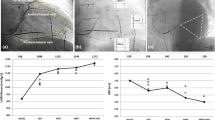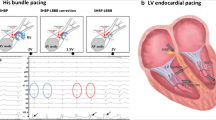Abstract
Background: Left ventricular pacing (LVP) and biventricular pacing (BVP) have been proposed as treatments for patients with advanced heart failure complicated by discoordinate contraction due to intraventricular conduction delay. For patients in sinus rhythm, BVP works in part by modulating the electronic atrial-ventricular time delay and thus optimizing contractile synchrony, the contribution of atrial systole, and reducing mitral regurgitation. However, little is known of the mechanisms of BVP in heart failure patients with drug-resistant chronic atrial fibrillation.
Hypothesis and Methods: LVP differs from BVP because hemodynamic and clinical improvement occurs in association with prolongation rather than shortening of the QRS duration. We sought to determine if LVP or BVP improves mechanical synchronization in the presence of atrial fibrillation. Thirteen patients with chronic atrial fibrillation, severe heart failure and QRS ≥140 ms received (after His bundle ablation) a pacemaker providing both LVP and BVP. The mean age was 62 ± 6 years and left ventricular ejection fraction was 24 ± 8%. After a baseline phase of one month with right ventricular pacing, all patients underwent in random order 2 phases of 2 months (LVP and BVP). At the end of each phase, an echocardiogram, a hemodynamic analysis at rest and during a 6-minute walking test and a cardio-pulmonary exercise test were performed.
Results: LVP and BVP provided similar performances at rest (p = ns). The 6-minute walking test revealed similar performances in both pacing modes but patients were significantly more symptomatic at the end of the test with LVP (p = 0.035). The cardio-pulmonary exercise test showed higher performances with BVP (92 ± 34 Watts) vs. LVP (77 ± 23; p = 0.03). LVP was associated with significantly more premature ventricular complexes recorded during the 6 minute walking test (49 ± 71) than BVP (10 ± 23; p = 0.04).
Conclusions: In this small series of patients with atrial fibrillation, congestive heart failure and a prolonged QRS duration, LVP and BVP provided similar hemodynamic effects at rest whereas BVP was associated with better hemodyamic effects during exercise and fewer premature ventricular complexes. Although the mechanisms for the observed differences are uncertain, it is possible that there is worsening of right ventricular function due to a rise in left-to-right electromechanical delay during exercise. Increased catecholamines release might contribute to the lower exercise tolerance and greater number of premature ventricular complexes recorded during exercise observed during LVP compared to BVP.
Recommendations: Patients with atrial fibrillation, heart failure and QRS prolongation who are candidates for His-bundle ablation and cardiac resynchronization therapy may respond better to BVP rather than to LVP.
Similar content being viewed by others
References
Leclercq C, Cazeau S, Le Breton H, Ritter P, Mabo P, Gras D, Pavin D, Lazarus A, Daubert JC. Acute hemodynamic effects of biventricular DDD pacing in patients with endstage heart failure. J Am Coll Cardiol 1998;32:1825–1831.
Kass DA, Chen CH, Curry C, Talbot M, Berger R, Fetics B, Nevo E. Improved left ventricular mechanics from acute VDD pacing in patients with dilated cardiomyopathy and ventricular conduction delay. Circulation 1999;99:1567–1573.
Blanc JJ, Etienne Y, Gilard M, Mansourati J, Munier S, Boschat J, Benditt DG, Lurie KG. Evaluation of different ventricular pacing sites in patients with severe heart failure: results of an acute hemodynamic study. Circulation 1997;96:3273–3277.
Etienne Y, Mansourati J, Gilard M, Valls-Bertault V, Boschat J, Benditt DG, Lurie KG, Blanc JJ. Evaluation of left ventricular based pacing in patients with congestive heart failure and atrial fibrillation. Am J Cardiol 1999;83:1138–1140.
Nelson GS, Berger RD, Fetics BJ, Talbot M, Hare JM, Kass DA, Spinelli JC. Left ventricular or biventricular pacing improves cardiac function at diminished energy cost in patients with dilated cardiomyopathy and left bundle branch block. Circulation 2000;102:3053–3059.
Bordachar P, Garrigue S, Reuter S, Hocini M, Kobeissi A, Gaggini G, Jaïs P, Haïssaguerre M, Clementy J. Hemodynamic assessment of right, left and biventricular pacing by peak endocardial acceleration and echocardiography in patients with end-stage heart failure. Pacing Clin Electrophysiol 2000;23:1726–1730.
Nelson GS, Curry CW, Wyman BT, Declerck J, Talbot M, Berger RD, McVeigh ER, Kass DA. Predictors of systolic augmentation from left ventricular preexcitation in patients with dilated cardiomyopathy and intraventricular conduction delay. Circulation 2000;101:2703–2709.
Garrigue S, Jais P, Espil G, Labeque JN, Hocini M, Shah DC, Haissaguerre M, Clementy J. Comparison of chronic biventricular pacing between epicardial and endocardial left ventricular stimulation using Doppler tissue imaging in patients with heart failure. Am J Cardiol 2001;88:858–862.
Yu CM, Chau E, Sanderson JE, Fan K, Tang MO, Fung WH, Lin H, Kong SL, Lam YM, Hill MR, Lau CP. Tissue Doppler echocardiographic evidence of reverse remodeling and improved synchronicity by simultaneously delaying regional contraction after biventricular pacing therapy in heart failure. Circulation 2002;105:438–445.
Kerwin WF, Botvinick EH, O'Connell JW, Merrick SH, DeMarco T, Chatterjee K, Scheibly K, Saxon LA. Ventricular contraction abnormalities in dilated cardiomyopathy: Effect of biventricular pacing to correct interventricular dyssynchrony. J Am Coll Cardiol 2000;35:1221–1227.
Toussaint JF, Lavergne T, Kerrou K, de Dieuleveult B, Ponce F, Froissart M, Le Heuzey JY, Guize L, Paillard M. Ventricular coupling of electrical and mechanical dyssynchronization in heart failure patients. Pacing Clin Electrophysiol 2002;25:178–182.
Sogaard P, Kim WY, Jensen HK, Mortensen P, Pedersen AK, Kristensen BO, Egeblad H. Impact of acute biventricular pacing on left ventricular performance and volumes in patients with severe heart failure: A tissue Doppler and three-dimensional echocardiographic study. Cardiology 2001;95:173–182.
Auricchio A, Stellbrink C, Block M, Sack S, Vogt J, Bakker P, Klein H, Kramer A, Ding J, Salo R, Tockman B, Pochet T, Spinelli J. Effect of pacing chamber and atrioventricular delay on acute systolic function of paced patients with congestive heart failure. Circulation 1999;99:2993–3001.
Prinzen FW, Van Oosterhout MF, Vanagt WY, Storm C, Reneman RS. Optimization of ventricular function by improving the activation sequence during ventricular pacing. Pacing Clin Electrophysiol 1998;21:2256–2260.
Wyman BT, Hunter WC, Prinzen FW, McVeigh EA. Mapping propagation of mechanical activation in the paced heart with MRI tagging. Am J Physiol 1999;276:H881–H891.
Prinzen FW, Hunter WC, Wyman BT, Mc Veigh ER. Mapping of regional myocardial strain and work during ventricular pacing: Experimental study using magnetic resonance imaging tagging. J Am Coll Cardiol 1999;33:1735–1742.
Hochleitner M, H¨ortnagl H, Ng C-K, Gschnitzer F, Zechmann W. Usefulness of physiologic dual-chamber pacing in drug-resistant idiopathic dilated cardiomyopathy. Am J Cardiol 1990;66:198–202.
Hochleitner M, H¨ortnagl H, Fridrich L, Gschnitzer F. Longterm efficacy of dual-chamber pacing in the treatment of end-stage idiopathic dilated cardiomyopathy. Am J Cardiol 1992;70:1320–1325.
Brecker SJ, Xiao HB, Sparrow J, Gibson DG. Effects of dual-chamber pacing with short atrioventricular delay in dilated cardiomyopathy. Lancet 1992;340:1308–1312.
Jochim K. The contribution of the auricles to ventricular filling in complete heart block. AmJ Physiol 1938;122:639–645.
Mitchell JH, Gilmore JP, Sarnoff SJ. The transport function of the atrium: Factors influencing the relation between mean left atrial pressure and left ventricular end-diastolic pressure. Am J Cardiol 1962;9:237–247.
Gesell RA. Auricular systole and its relation to ventricular output. Am J Physiol 1911;29:32–63.
Skinner NSJr, Mitchell JH, Wallace AG, Sarnoff SJ. Hemodynamic effects of altering the timing of atrial systole. Am J Physiol 1963;205; 499–503.
Nishimura RA, Hayes DL, Holmes DR, Tajik AJ. Mechanism of hemodynamic improvement by dual-chamber pacing for severe left ventricular dysfunction: An acute Doppler and catheterization hemodynamic study. J Am Coll Cardiol 1995;25:281–288.
Iwase M, Sotobata I, Yokota M, Takagi S, Jing HX, Kawai N, Hayashi H, Murase M. Evaluation by pulsed Doppler echocardiography of the atrial contribution to left ventricular filling in patients with DDD pacemakers. Am J Cardiol 1986;58:104–109.
Kataoka H. Hemodynamic effect of physiological dual chamber pacing in a patient with end-stage dilated cardiomyopathy: A case report. Pacing Clin Electrophysiol 1991;14:1330–1335.
Auricchio A, Sommariva L, Salo RW, Scafuri A, Chiariello L. Improvement of cardiac function in patients with severe congestive heart failure and coronary artery disease by dual chamber pacing with shortened AV delay. Pacing Clin Electrophysiol 1993;16:2034–2043.
Appleton CP, Basnight MA, Gonzalez MS. Diastolic mitral regurgitation with atrioventricular conduction abnormalities: Relationships of mitral flow velocity to transmitral pressure gradients in conscious dogs. J Am Coll Cardiol 1991;18:843–849.
Rutishauser W, Wirz P, Gander M, Lüthy E. Atriogenic diastolic reflux in patients with atrioventricular block. Circulation 1966;34:807–817.
Panidis IP, Ross J, Munley B, Nestico P, Mintz GS. Diastolic mitral regurgitation in patients with atrioventricular conduction abnormalities: A common finding by Doppler echocardiography. J AmColl Cardiol 1986;7; 768–774.
Schnittger I, Appleton CP, Hatle LK, Popp RL. Diastolic mitral and tricuspid regurgitation by Doppler echocardiography in patients with atrioventricular block: New insight into the mechanism of atrioventricular valve closure. J Am Coll Cardiol 1988;11:83–88.
Naito M, David D, Michelson EL, Schaffenburg M, Dreifus LS. The hemodynamic consequences of cardiac arrhythmias: Evaluation of the relative roles of abnormal atrioventricular sequencing, irregularity of ventricular rhythm and atrial fibrillation in a canine model. Am Heart J 1983;106:284–291.
Clark DM, Plumb VJ, Epstein AE, Kay GN. Hemodynamic effects of an irregular sequence of ventricular cycle lengths during atrial fibrillation. JAmColl Cardiol 1997;30:1039–1045.
Leclercq C, Walker S, Linde C, Clementy J, Marshall AJ, Ritter P, Djiane P, Mabo P, Levy T, Gadler F, Bailleul C, Daubert JC. Comparative effects of permanent biventricular and right-univentricular pacing in heart failure patients with chronic atrial fibrillation. Eur Heart J 2002;23:1780–1787.
Garrigue S, Bordachar P, Reuter S, Jaïs P, Kobeissi A, Gaggini G, Haïssaguerre, Clementy J. Comparison of permanent left ventricular and biventricular pacing in patients with heart failure and chronic atrial fibrillation: Prospective haemodynamic study. Heart 2002;87:529–534.
Touiza A, Etienne Y, Gilard M, Fatemi M, Mansourati J, Blanc JJ. Long-term left ventricular pacing: Assessment and comparison with biventricular pacing in patients with severe congestive heart failure. J Am Coll Cardiol 2001;38:1966–1970.
Garrigue S, Reuter S, Efimov IR, Mazgalev TN, Jais P, Haissaguerre M, Clementy J. Optical mapping technique applied to biventricular pacing: Potential mechanisms of ventricular arrhythmias occurrence. Pacing Clin Electrophysiol 2003;26:197–205.
Verbeek XAAM, Vernooy K, Peschar M, Cornelussen RNM, Prinzen FW. Intra-ventricular resynchronization for optimal left ventricular function during pacing in experimental left bundle branch block. J Am Coll Cardiol 2003;42:558–567.
Wood JC, Festen MP, Lim MJ, Buda AJ, Barry DT. Regional effects of myocardial ischemia on epicardially recorded canine first heart sound. J Appl Physiol 1994;76:291–302.
Rickards AF, Bombardini T, Corbucci G, Plicchi G. An implantable intracardiac accelerometer for monitoring myocardial contractility. Pacing Clin Electrophysiol 1996;19:2066–2071.
Xiao HB, Brecker SJD, Gibson DG. Effects of abnormal activation on the time course of the left ventricular pressure pulse. Br Heart J 1992;68:103–107.
Xiao HB, Roy C, Gibson DG. Nature of ventricular activation in patients with dilated cardiomyopathy: Evidence for bilateral bundle branch block. Br Heart J 1994;72:167–174.
Cazeau S, Bordachar P, Jauvert G, Lazarus A, Alonso C, Vandrell MC, Mugica J, Ritter P. Echocardiographic modeling of cardiac dyssynchrony before and during multisite stimulation: a prospective study. Pacing Clin Electrophysiol 2003;26:137–143.
Cazeau S, Gras D, Lazarus A, Ritter P, Mugica J. Multisite stimulation for correction of cardiac asynchrony. Heart 2000;84:579–581.
Hesse B, Diaz LA, Snader CE, Blackstone EH, Lauer MS. Complete bundle branch block as an independent predictor of all-cause mortality: Report of 7073 patients referred for nuclear exercise testing. Am J Med 2001;110:318–319.
Leclercq C, Kass DA. Retiming the failing heart: Principles and current clinical status of cardiac resynchronization. J Am Coll Cardiol 2002;39:194–201.
Author information
Authors and Affiliations
Rights and permissions
About this article
Cite this article
Garrigue, S., Bordachar, P., Reuter, S. et al. Comparison of Permanent Left Ventricular and Biventricular Pacing in Patients with Heart Failure and Chronic Atrial Fibrillation: A Prospective Hemodynamic Study. Card Electrophysiol Rev 7, 315–324 (2003). https://doi.org/10.1023/B:CEPR.0000023167.11038.8f
Issue Date:
DOI: https://doi.org/10.1023/B:CEPR.0000023167.11038.8f




